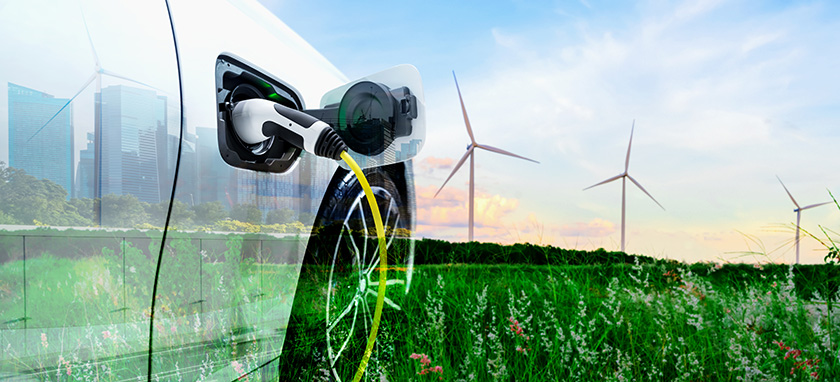More news
- Focus on industrial: Powering the energy industry during extreme heat
- Focus on powder coatings: The coatings industry’s transition to PFAS/PTFE-free solut...
- “We see sustainability as a purpose, as a reason for doing business” – P...
- Focus on industrial: High-performance coating protects tanks at biopolymer production plan...
- Focus on powder coatings: Novel high-speed crosslinking technology

Ed Zwirn, New York, Julian Ryall, Tokyo and Sara Lewis, Brussels, report for PPCJ on the latests trends and innovations in the automotive coatings industry
The automotive industry is undergoing transformational change as it moves toward low or zero emissions technology such as electric vehicles – so it is no surprise that significant innovation is being introduced to vehicle paints and coatings.
Europe focuses on sustainability
In Europe, for example, sustainability, safety and technology are driving the latest trends in car coatings.
The need to lower emissions of volatile organic compounds (VOC) and other solvents has inspired a shift towards water-based paints, which also require lower production temperatures, lowering manufacturers’ carbon footprint. The use of renewable raw materials, such as biomass, is expanding too.
Coatings are now integral to vehicle safety, aiding the operations of radar detectors, with higher reflectivity, and boosting the effectiveness of light detection and ranging (LiDAR) sensors. Both radar and LiDAR are crucial for advanced driver assistance systems (ADAS), which will be increasingly important as autonomous driving systems are developed – but dark and metallic hues can interfere with transmission. Germany-based chemical manufacturing company BASF, as a result, has developed a system of basecoats and primers, including bumper substrate or coatings, for optimum use with radar and LiDAR, the latter involving near-infrared (NIR) scattering pigments and layers to reflect light beams.
The growing popularity of electric and hybrid vehicles is also being reflected in colour choices, with electric blue hues “taking centre stage”, according to a LinkedIn post [1] from Swansea, Wales-based paint and coatings supplier Independent Paint Supplies Ltd, which also flagged among 2024 trends: “earthy tones like soft greens, warm browns, and muted terracotta” to reflect eco-awareness; neutral shades “with a twist”; and, colour-shift paints that change depending on the viewing angle and light.
Colour shifts feature in BASF’s latest automotive colour trend collection 2023-2024 ‘ON VOLUDE’ [2]. ‘Predictor’ – an orange-beige hue – is the top pick in the Europe, Middle East, and Africa (EMEA) palette, which features beiges and pastels not usually sprayed onto automotives. The mid-blue ‘Zenomenon’ heads the Americas favoured palette, and the light green ‘Electronic Citrus’, BASF’s Asia-Pacific collection sales.
“Some of the colour concepts may be visible on the roads in the next three-to-five years but it does not mean that achromatic colours [white, grey and black] will disappear,” Mark Gutjahr, Head of Automotive Colour Design, EMEA (Europe, Middle East and Africa), for BASF, stressed to PPCJ. Indeed, BASF’s new collection also features “new and modern interpretations of whites, greys and blacks as these are still the most prominent colours,” he said.
Meanwhile, a growing trend of integrating additional functions into car interiors, such as touch-sensitive haptics, is increasing demand for abrasion-resistant coatings. Also on the rise are new materials, such as fabrics painted to reflect the rest of the interior, creating a harmonious design.
READ MORE:
Automotive coatings: Innovation for more sustainable textile coatings
North America – a robust economic recovery
In the USA, automotive coatings production and sales are enjoying a robust recovery from the disruptions and restrictions brought on by the COVID-19 pandemic. Miles driven by automotives and light trucks are rising back sharply to approach pre-pandemic levels, and this trend is expected to continue well into 2024, according to the Washington DC-based American Coatings Association.
At the same time, increasing disposable incomes generated by the USA’s robust economic recovery from the pandemic has led more Americans to buy SUVs (sport utility vehicles) and other high-end vehicles, leading to increased demand for advanced exterior and interior coating solutions. Also, the government subsidy-fuelled adoption of electric vehicles and hybrids has changed requirements for coatings.
Emmanuelle Guerin, Vice President of auto parts and commercial vehicles for US-paint major PPG, said: “This includes materials that improve battery performance, including dielectric and thermal isolation materials, as well as fire protection solutions that increase occupant safety…” She also stressed the importance of coatings that are compatible with or even enhance radar signals used in advanced driver assistance systems. “There is also a demand for original colour palettes for EVs and other creative design trends to differentiate them from traditional gasoline vehicles,” she added, “Including special body trims and larger greenhouses and special lighting designs.” Customers in both the OEM and refinishing markets are also looking for solutions that reduce their CO2 footprint and increase circularity, increasing productivity and process efficiency and reducing energy consumption in the paint shop. These functionalities are an important part of PPG auto industry customers’ decarbonisation strategy and a key selling point, she added.
Looking ahead, coatings suppliers to the US auto sector continue to innovate with self-healing and self-cleaning coatings, self-stratifying coatings, coatings with pollution-eating properties, “smart” coatings that respond to stimuli by altering their properties, burnish- and scratch-resistant matte coatings, and coatings with solar heat management.
“Today’s consumers are increasingly demanding distinctive and personalised vehicles and colour is a significant consideration for them,” said Daniel Daley, Senior Consultant for Ohio-based chemical manufacturing company The ChemQuest Group, “We’re seeing an increased interest in solid colours, which results in a decline for metallic colours and special effects. Instead, buyers are looking for variety and depth in terms of colour choice, as well as sustained brilliance over the life of the vehicle.”
As for environmental good practice, he said: “Automotive OEMs are seeking improved performance related to brilliance and sustained colour over the vehicle’s life. They are also turning to sustainable colours that are made with recycled materials and have a lower environmental impact. Coatings companies are working to address these needs by developing more durable coatings that hold a vehicle’s resale value by maintaining the ‘new-car’ look, as well as more sustainable options such as natural pigments.”
READ MORE:
Japan looks to electric vehicles
Environmental concerns are also changing the Japanese auto industry paint and coating market, particularly as this country also shifts towards electric vehicles.
“We are focusing on reducing CO2 emissions, which is a common issue for EV manufacturers,” said Kazumi Nishimura, spokeswoman for Osaka-based Kansai Paint. “One of our efforts focuses on reducing the distance between the car body and the spray gun, thereby reducing waste and contributing to the reduction of CO2 emissions,” she told PPCJ.
“Currently, we are in the process of gradually reducing the distance from about 30cm while taking into consideration the thickness of the coating film,” she said. “Additionally, in the drying process for topcoats, which requires lower temperatures, we are working to reduce the temperature from the usual 140 degrees.”
The auto sector eco-shift is also changing coatings colours here, too. Simple shades of white, silver and black that have long dominated Japan’s streets are still there, but analysts say consumers are becoming more daring.
BASF Japan said solid-feel opaque greys and shades of the colour, such as ‘petrol grey’ that “look like solid, non-metallic colours…are becoming more expressive through the addition of aluminium or pearl flakes,” said Chiharu Matsuhara, Head of Design, Asia Pacific, BASF. “This gives an unusual effect in automotive exterior colours and has brought new aesthetics to the industry,” he told PPCJ.
Chromatic blue has been growing in popularity, said Matsuhara, with green, from ‘fresh green’ to almost khaki, with greyish tones, particularly fashionable among SUV owners.
Kansai said its automotive sector sales rebounded to Japanese Yen JPY149.4bn (US$1.01bn) in the fiscal year between April 2022 and March 2023, primarily due to increased vehicle production after the pandemic and rising demand in India and Europe.
Auto coatings accounted for 39% of the firm’s total domestic sales during the period, said Nishimura, and 61% of overseas sales.
“We are finding that natural colours, earth tones, are currently popular, with textures between solids and metallic,” she said. “We believe that colours with calm tones inspired by nature are presently matching the sensibilities of consumers who are seeking comfort.”
And Kansai is developing coatings that allow consumers to change their car colour without an expensive respray: “Based on the concept of ‘making people happy with the colour of an automobile,’ we have succeeded in developing a technology that enables us to paint a car the colour we like at the time of purchase but then later peel off that layer to reveal another colour,” said Nishimura.







